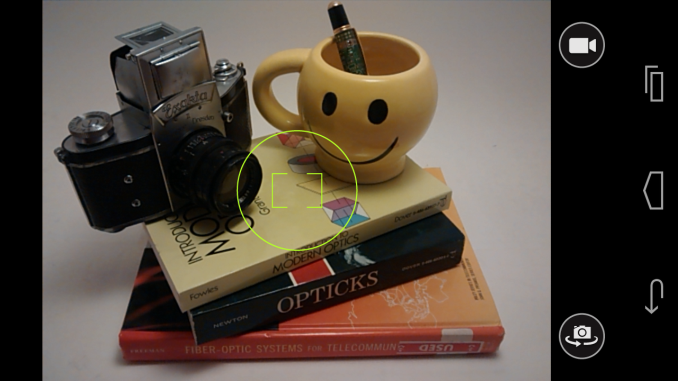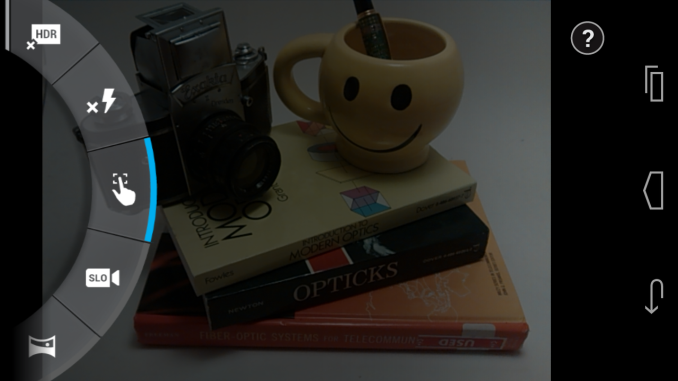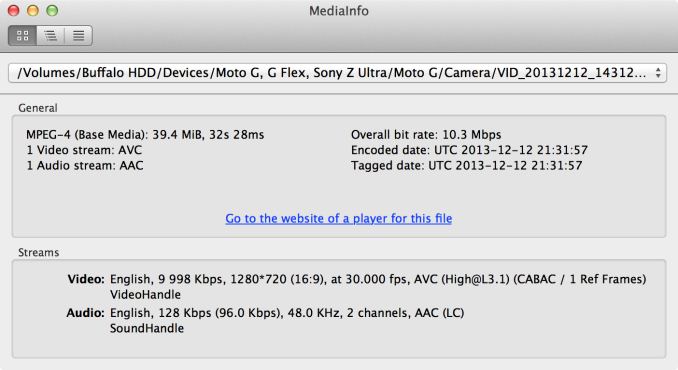Motorola Moto G Review
by Brian Klug on December 18, 2013 2:00 PM EST- Posted in
- Smartphones
- Motorola
- Mobile
- *VA
- Cortex A7
- snapdragon 400
- Moto G
On the camera side the Moto G includes a 5 MP rear facing camera with autofocus and LED flash, on the front it includes a 1.3 MP camera. I did some digging and found that the rear facing camera CMOS is an Aptina AR0543 CMOS. There’s nothing on Aptina’s website about the AR0543, but there is an AR0542 which probably is its predecessor with 1/4 Inch format and 1.4 μm pixels. I suspect this is exactly the form factor of the sensor in Moto G, with some slight improvements, I believe the color filter array is Bayer as well, not RGBW like Moto X. The rear facing camera module has a focal length of 3.5 mm which works out to around a 37mm focal length in 35mm-equivalent units, the system has an F/# of 2.4, which is great for a device of this cost.
On the front is the Aptina MT9M114 1.3 MP, 1/6 Inch with 1.9 µm pixels sensor that we’ve seen a lot of in recent days.
Motorola uses the same camera application as the Moto X, and reflects the most recent UI changes that have rolled out in both OTAs and through the Play Store. The biggest change is a new spot focus and exposure point which can be dragged around the live preview. Motorola calls it manual focus and exposure, in practice it’s really a weighted spot meter and focus point that you can drag around. I’d only call what LG has on the G2 or Nokia bundles as manual focus, but the new camera app is a substantial improvement over the UI as it launched with the Moto X, which didn’t afford any exposure or metering controls (instead taking a scene average), only tap to focus, which ran a full AF search wherever you tapped.
The camera settings menu still is a ring chooser that slides out with a drag from the left side, and has settings for HDR, flash, tap to focus/expose, slow motion video, panorama, location, a new aspect ratio toggle (16:9 and 4:3) and shutter sound. The aspect ratio toggle is what’s new versus the X, since the Moto G has a standard 4:3 aspect ratio sensor and not the 16:9 aspect ratio aspect ratio of the Moto X. By default the Moto G launches with the 16:9 aspect ratio for image capture, cropping off part of the image area, but tapping 4:3 gives you a proper live, full field of view, 4:3 preview. Major kudos to Motorola for giving an aspect-correct live preview. Shot to shot latency is longer than Moto X or other flagships, but not inordinately long or on the order of seconds. I should note that the Moto G does not include the same wrist-flick camera activation gesture as the Moto X.
To evaluate image quality we turn to the usual combination of photos taken at the bench locations, although location 7 wasn’t available, and photo tests in a lightbox with lights on, and off, and of test charts. I also continue to take photos while out and about with devices to get samples in a variety of other conditions.
Moto G still image quality is better than I had suspected. Outdoors in well lit scenes the Moto G is totally capable of delivering good quality shots with good exposure and focus.
My only major criticism is that there’s definitely some off-axis loss of sharpness, the leftmost part of almost every image gets blurry quickly, the right side doesn’t show nearly as much. Alignment tolerances for smartphone optics are a part of module cost, I wouldn’t be surprised to see variance like this. In low light or indoors, the Moto G occasionally struggles to produce images without blur, but that’s a complaint I still levy against some modern flagships. There’s also a bit of light leakage on the Moto G which crops up when outdoors, but nothing crazy. Front facing camera quality is totally par with other flagships I’ve tried, which isn’t surprising.
Camera - Video
On the video side, the Moto G’s interface is, no surprise, just like the Moto X. There’s a video button that immediately starts video capture, successive taps in the image area capture still frames from the live video. Although MSM8x26 supports up to 1080p30 video encode for H.264, Moto G oddly enough captures video at 720p30 in H.264 High profile at 10 Mbps. Audio is stereo thankfully at 128 kbps AAC.
As always I’ve uploaded a copy of the video recorded at the usual place to YouTube and to our servers for you to look at without the additional compression.
Video from the Moto G is well exposed and appears great for being 720p. I would personally miss 1080p, but the Moto G seems great for the resolution it affords. There’s no dropped frames or visible macroblocking, and exposure seems good, again my only desire would be for 1080p resolution.























































120 Comments
View All Comments
haukionkannel - Wednesday, December 18, 2013 - link
True, but this is not power user phone. The Noto X is for that purpose. For normal mister Smith this is very good phone indeed. But so is/are allso Lumia 52x phone(s), so comparison would be nice as someone above allready said.fic2 - Wednesday, December 18, 2013 - link
My girlfriend has a 521. It is a nice phone, but the HUGE problem is having to do a hard reset every time there is an upgrade. A hard reset looses all settings. And MS seems incapable of doing a backup that actually backs up everything. The stuff they do backup has to go to "the cloud" (to be datamined by them and the NSA). And when you do a restore it is a one-shot and can only be done over 3G since wireless isn't enabled at the time.Because of this I am thinking about getting her a Moto G.
skiboysteve - Saturday, December 21, 2013 - link
What are you talking about? WP updates are OTA incremental and never require a hard reset...shaduck007 - Saturday, January 4, 2014 - link
thanks for Mentioning the Lumia, it's 1/3 the price of the MOTO G.Thinking of what is the best value!!
Sam
sephirotic - Wednesday, February 5, 2014 - link
If this is not a power use phone then why add quad core, instead of a dual core processor, and a 720p screen? Witch is cheaper and more usefull, that or a SD card slot?grayson_carr - Wednesday, December 18, 2013 - link
Are power users interested in this phone as their main device? If 8 or 16GB was fine for the flagship Nexus 4 13 months ago, I think it's fine for a low cost phone now.grayson_carr - Wednesday, December 18, 2013 - link
Lets not forget, the average consumer still buys a 16GB iPhone or 16GB Galaxy S4 and doesn't put in a microSD card in the case of the GS4.fokka - Wednesday, December 18, 2013 - link
source? regarding the s4 i mean.flyingpants1 - Wednesday, December 18, 2013 - link
The average consumer doesn't actually use their phone for more than an hour or two a day, leaving it in sleep state 95% of the time and somehow assumes this means it has "good battery life".The average consumer does not store hours of movies on their phone, or watch movies on their phone at all.
The average consumer also can't see the difference between a 5mp camera and a 13mp camera.
The average consumer sees almost no benefit from 7mbit HSPA+ to 30mbit LTE.
The average consumer doesn't care about front speakers or waterproofing.
The average consumer doesn't use a wireless charger.
The average consumer CANNOT. SEE. The difference between a 540x960 display and a 1080p display.
The average consumer doesn't run more than a couple apps at the same time.
The average consumer doesn't care about read/write speeds of the NAND on their phone.
The average consumer doesn't know the difference between LCD and AMOLED.
Smartphones are ubiquitous now. Every grandma has a $0 iPhone that they don't know how to use. This doesn't mean we should stop making things better. For god's sake don't make us all suffer on behalf of your demented relatives.
apertotes - Wednesday, December 18, 2013 - link
it was not fine for nexus 4. And I explicitly said that it was not a poweruser scenario at all.